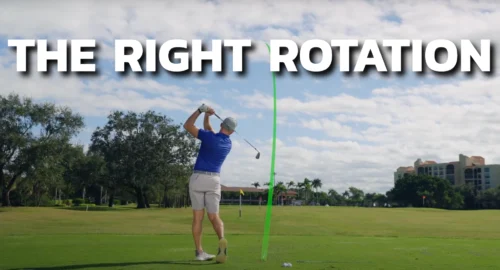
Ask any great ball striker how they got there, and they won’t tell you about some secret move halfway through their swing. As complicated as golf is, it starts much simpler than this. You’ll likely hear most great players tell you that everything comes back to the golf swing fundamentals.
Grip, setup, backswing, downswing, impact, and follow-through are the six cornerstones of a consistent, powerful golf swing.
Whether you’re a beginner or just trying to rebuild your swing from the ground up, this guide will walk you through each of these fundamentals in a practical, easy-to-understand way. You’ll learn some of the most common mistakes and some ways that you can improve.
Grip: Your Only Connection to the Club
The grip is where it all starts. If your hands aren’t positioned correctly on the club, everything that follows becomes a compensation. A good grip allows you to control the clubface, get the club on the correct swing plane, and play more consistent golf.
A great golf grip starts in your fingers (not your palm). When the club is in your fingers, it’s easier to manage grip pressure and square the clubface.
For proper placement of your hands on the golf club, you’ll want to look down and see 2-2.5 knuckles on the lead hand. The V formed between your thumb and index finger should point toward your trail shoulder.
Most players do best with the overlap grip (also called the Vardon grip), where the pinky of the trail hand rests on top of the index finger of the lead hand. Smaller hands? You may prefer the interlock.
Common Mistakes to Avoid
- Weak grip (V’s pointing left): Often leads to slices and weak contact.
- Strong grip (V’s pointing far right): Promotes a closed face and possible hooks.
- Gripping too tightly adds tension and restricts your motion.
- Gripping too much in the palm.
The Setup: Build the Swing Before It Starts
Every great swing starts before the club moves. Your setup controls balance, alignment, and your ability to deliver the club consistently. Get it wrong, and the rest of your swing becomes a recovery act.
The difficult thing about the setup in golf is that you have to make adjustments depending on the club you are playing. The three most important parts of setup that you should pay attention to are ball position, posture, shoulder tilt, and head position and alignment.
Ball Position
Proper ball position affects launch, spin, and strike location.
- Driver: Inside your lead heel for upward strike.
- Fairway Woods and Hybrids: Place the golf ball somewhere between the lead heel position and the center of your stance, depending on the club.
- Irons: Gradually more centered with shorter clubs.
Posture
Your weight should feel balanced across the balls of your feet, not on your heels or toes.
- Hinge at the hips, not the waist.
- Let your arms hang naturally, knees slightly flexed.
- Keep your spine straight but relaxed, no slouching or stiffness.
Shoulder Tilt and Head Position
With longer clubs, especially the driver, your trail shoulder should be slightly lower than your lead shoulder. This promotes a better launch and helps you stay behind the ball.
Alignment
Align your feet, hips, and shoulders parallel to the target line. A closed or open setup creates problems before you ever take the club back. A misaligned setup leads to directional misses, even with a good swing.
Use an alignment stick to check both your stance and ball position.
Backswing: Load Without Losing Control
The backswing is where you store energy and create the conditions for a solid strike. If your grip and stance are correct, it’s much easier to get the club started on the right plane. The backswing should be a controlled movement that properly loads and turns the body.
You’ll want to start with a smooth takeaway. When the shaft is parallel to the ground, the clubhead should be just outside the hands, and the face should be square. Maintain your posture throughout your swing and don’t “stand up”.
Your head should stay centered, and your weight should shift to the trail side without swaying. The goal is to rotate around a stable base.
Common Backswing Mistakes:
- Pulling the club too far inside during the takeaway.
- Lifting with the arms instead of rotating with the lower body.
- Swaying off the ball instead of coiling.
Downswing: Let the Body Lead
A powerful downswing isn’t just about speed; it’s about sequencing. Golfers who are able to start the downswing using the larger muscles in the legs and core have more consistent results than those who try to swing with the hands and arms.
This sequencing allows you to create and store energy, rather than dumping it early.
As the hips start to open, the arms follow naturally, maintaining what’s known as “lag,” the angle between your lead arm and the club shaft.
To hold that angle and deliver the club with speed and control, it’s important to keep your trail elbow tucked and moving in toward your side. If it flares out or separates from the body too early, you may have weak contact.
Common Downswing Mistakes:
- Casting (early release) leads to weak contact and loss of power.
- Spinning the upper body too and using the hands and wrists too soon creates an over-the-top move.
- Losing wrist angles early eliminates lag and distance.
Impact: The Moment of Truth
Impact is the most important part of the golf swing. It’s the only moment the club actually touches the ball. Everything you’ve done up to this point was to set up this one instant.
Impact position isn’t one-size-fits-all. It depends on the club in your hand and the type of shot you’re trying to hit. But there are some key patterns you’ll see across good players.
With Irons
Your goal is a descending strike, hitting the ball first and the turf after.
- Forward shaft lean: The handle is slightly ahead of the clubhead at impact.
- Weight on the lead foot: Most of your pressure should be forward.
- Low point in front of the ball: That’s how you compress it..
Trying to scoop or “help” the ball into the air ruins this. The loft of the club does the work; your job is to strike down, not lift up.
Drill: Place an alignment stick 3–4 inches behind the ball. If you hit it, your weight’s back, or you’re flipping your wrists too soon.
With the Driver
Here, you want to hit up on the ball to maximize launch and reduce spin.
- Head stays behind the ball
- Slight upward angle of attack
- Hands roughly in line with the ball, not excessively forward
Many golfers try to “help” the ball into the air, which often results in pop-ups, spinny slices, or thin contact. Instead, feel like your chest stays behind the ball through impact, and your arms extend fully down the target line.
If your contact is inconsistent, the first place to look isn’t your swing; it’s your setup. Poor ball position, misaligned shoulders, or bad posture can force you to compensate. While all fundamentals are important, you must start with the basics to work your way to a great impact position.
The Follow-Through: Finish with Balance
While impact is the goal, your follow-through can provide valuable insight into your golf swing. Not enough amateur golfers pay attention to the follow-through as they assume, once the swing is over, that it won’t matter. If you’re falling off balance or finishing low and stuck, something went wrong earlier.
Your weight should be fully on the lead foot with your belt buckle and chest facing the target. Your trail foot will be rolled up on the toe with the heel off the ground.
You should be able to hold your finish without stumbling or resetting. A clean follow-through shows good sequencing, tempo, and body control. Make sure that even when you practice on the range, you are holding your finish position for at least three seconds. This simple task is great for reinforcement of the proper action.
Master the Fundamentals, Master the Golf Swing
A great golf swing doesn’t happen by accident; it’s built on solid fundamentals. Whether you’re fixing a slice, chasing more distance, or just trying to hit it more consistently, go back to these six building blocks.
Work on each one individually. Make sure that you spend enough time so that you feel confident before you move to the next one. If you find that you have an issue, work on building skills until you are ready to take your game to the next level.
While the basics may not seem as entertaining as learning to crank 300-yard drives you need to start with the small steps before you make it to the top.

